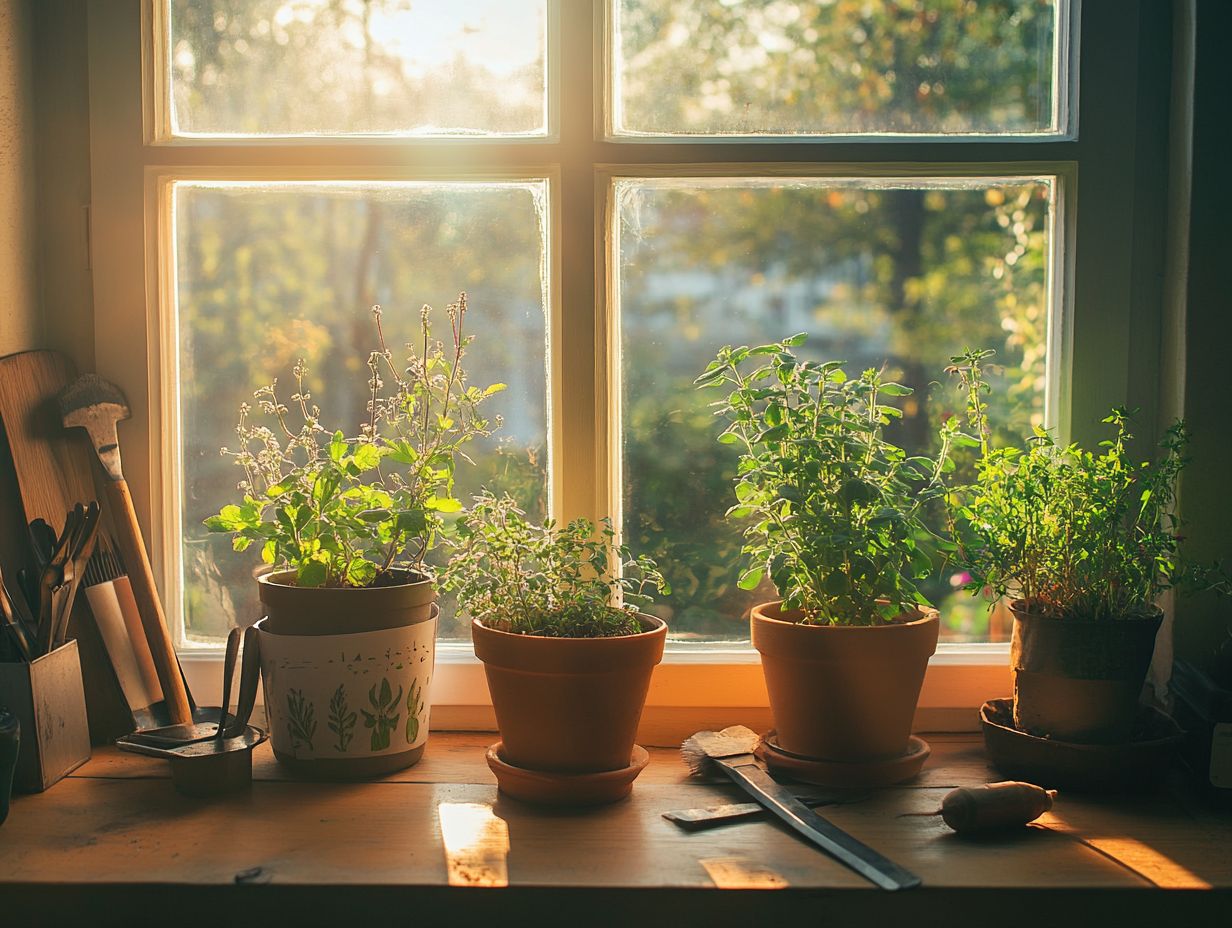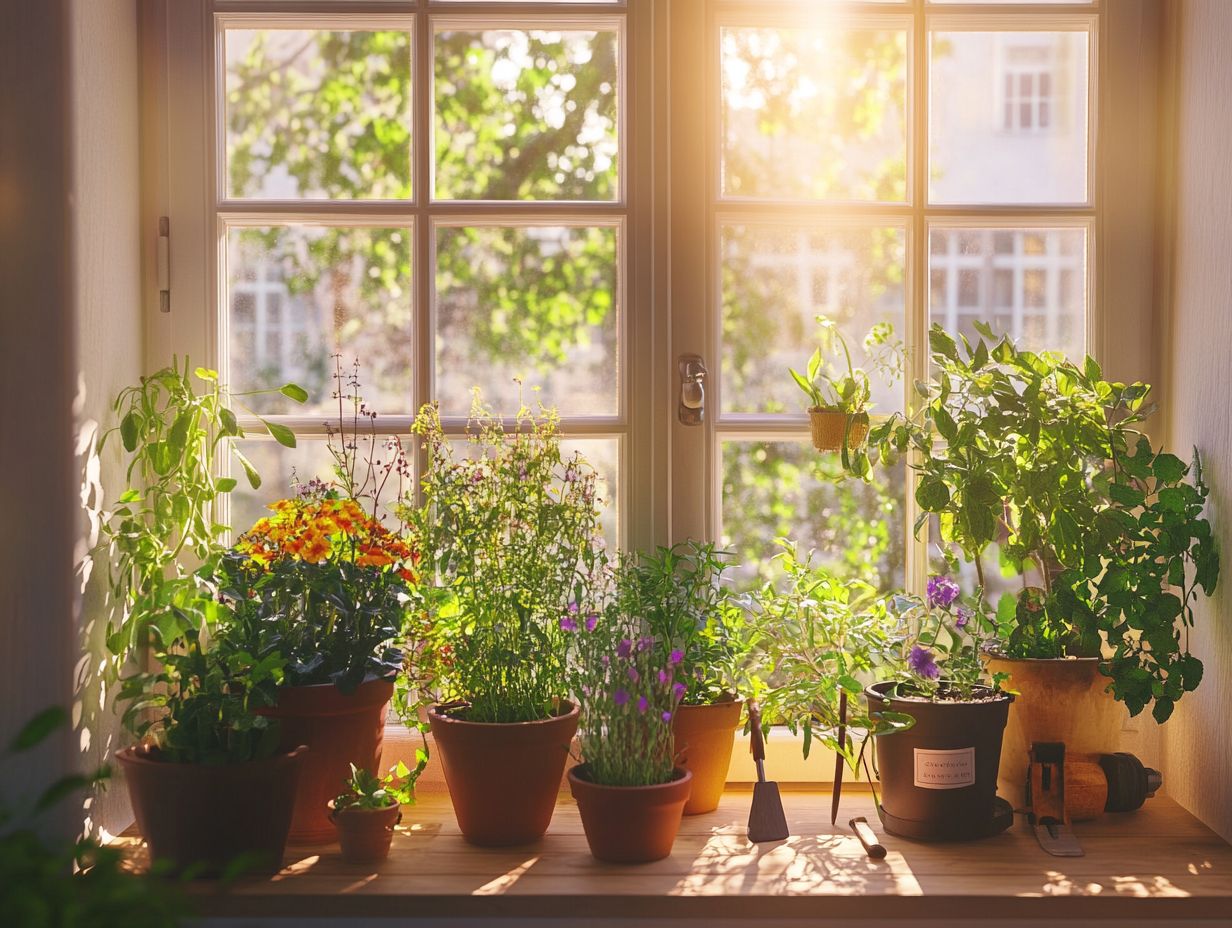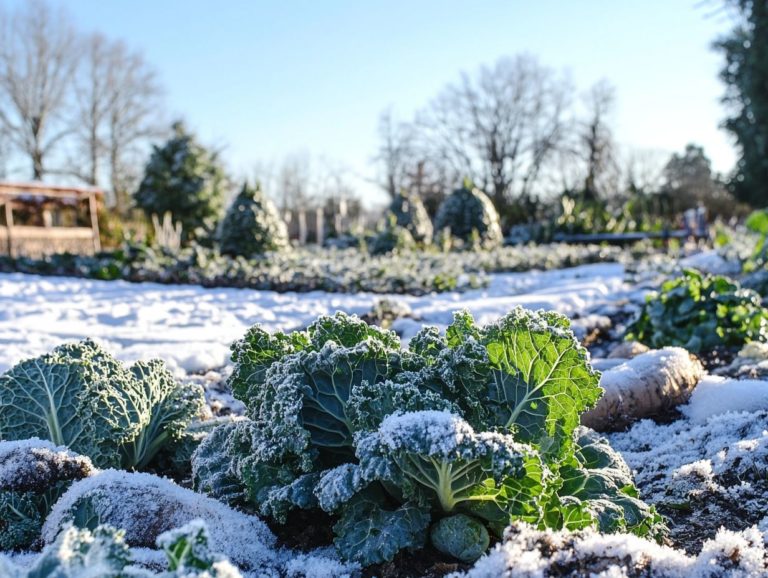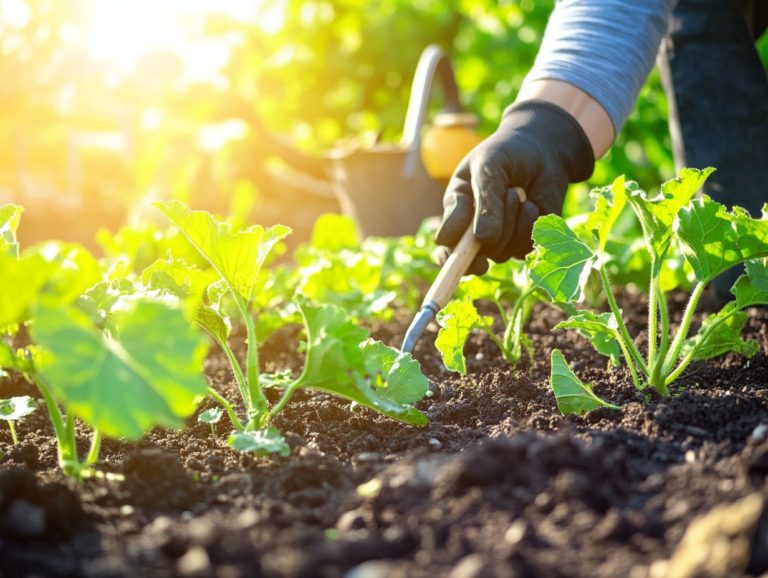5 Tips for Successful Indoor Winter Gardening
Winter may seem stark and lifeless, but indoor gardening presents a vibrant escape, infusing your home with greenery and joy.
Here are five essential tips for mastering indoor winter gardening, from choosing the perfect plants to crafting the ideal environment.
- You ll explore the benefits, tackle common challenges, and discover effective solutions.
- Get ready to be inspired with creative ideas and learn how to maintain a sustainable and eco-friendly indoor garden.
Dive into this winter and transform your space into a lush indoor paradise today!
Contents
- Key Takeaways:
- 1. Choose the Right Plants for Indoor Gardening
- 2. Create the Ideal Environment for Your Plants
- 3. Use the Right Tools and Containers
- 4. Provide Adequate Lighting and Watering
- 5. Regularly Monitor and Maintain Your Indoor Garden
- What Are the Benefits of Indoor Winter Gardening?
- Frequently Asked Questions
- What are the benefits of indoor winter gardening?
- What are the essential tools for successful indoor winter gardening?
- How often should I water my indoor winter garden?
- What are some good plants to grow in an indoor winter garden?
- How can I ensure proper air circulation in my indoor winter garden?
- How can I prevent pests from infesting my indoor winter garden?
Key Takeaways:

- Choose cold-hardy plants that are suitable for indoor gardening, such as herbs, leafy greens, and succulents.
- Control temperature, humidity, and light to create the optimal environment for your plants to thrive during winter.
- Use appropriate tools and containers, like grow lights and self-watering pots, to make indoor gardening more convenient and effective.
1. Choose the Right Plants for Indoor Gardening
Selecting the right plants for your indoor garden is essential for successful winter gardening. Understanding the top 5 challenges of winter gardening enables you to savor fresh produce all year round, even in colder climates like Utah.
Here, Rick Stone from Our Stoney Acres has perfected effective growing methods that allow indoor gardening to truly thrive. By thoughtfully curating a selection of resilient winter crops, you can cultivate a vibrant indoor garden that flourishes despite the chill outside. For more insights, check out these container gardening tips for winter.
Consider options like carrots, spinach, kale, Swiss chard, and bok choy; these not only thrive indoors but also allow for staggered harvests, ensuring a continuous supply of fresh greens and root vegetables.
Incorporating perennials into your mix can significantly boost your overall yield and sustainability. These hardy plants often require less care and provide abundant produce season after season. By choosing a diverse array of these plants, you enrich your gardening experience and contribute to a healthier lifestyle.
2. Create the Ideal Environment for Your Plants
Creating the ideal environment for your indoor garden is crucial for mimicking the natural microclimates in which plants thrive. Utilizing tools like cold frames, hoop houses, and high tunnels special structures that help maintain the right temperature for your plants allows you to regulate temperature and humidity effectively.
This meticulous setup enhances growth and ensures your plants receive the optimal amount of light and air circulation. Maintaining a consistent temperature ideally between 65 F and 75 F will foster an inviting growing atmosphere. Keeping humidity levels between 40% and 60% helps prevent common issues like mold.
Choosing the right tools, such as digital hygrometers and thermometers, enables you to monitor these conditions with precision. By embracing organic gardening practices in your space, you promote healthier plants and contribute to a sustainable environment, resulting in a bountiful yield that s free from synthetic chemicals.
3. Use the Right Tools and Containers
Using the right tools and containers is essential for your indoor gardening success, as they provide crucial support for your crops while optimizing space and resource usage.
You have a variety of options at your fingertips. Consider classic pots in different sizes for a range of plants, and seed trays that are perfect for nurturing seedlings in compact spaces. Vertical gardening solutions are also gaining traction, allowing you to make the most of vertical space and thrive even in smaller indoor environments.
By implementing protective tools like mini hoop houses, row covers, and cloches, you can shield your plants from harsh temperatures, pests, and unpredictable weather. This ensures that your indoor garden flourishes throughout the year, turning your green thumb into a thriving sanctuary.
Start your indoor garden adventure today and enjoy the wonders of fresh greens all winter long!
4. Provide Adequate Lighting and Watering

Providing adequate lighting and watering is essential for your indoor gardening success. To enhance your winter gardening experience, consider implementing 5 winter gardening hacks for success. Plants need specific light conditions and water levels to thrive, especially in winter when natural sunlight is scarce.
Among the various lighting options available, LED grow lights have become a favorite for their energy efficiency. They mimic sunlight well, emitting a spectrum of wavelengths suitable for different plants.
Establishing a consistent watering schedule is equally crucial. Techniques like drip irrigation or deep watering can significantly enhance moisture retention, keeping your plants happy and healthy.
When transitioning your plants outdoors, consider a hardening-off period. This gradual acclimatization helps them adjust to new conditions.
5. Regularly Monitor and Maintain Your Indoor Garden
Regularly monitoring and maintaining your indoor garden is crucial for fostering healthy growth and maximizing yields. This diligence enables timely harvesting and effective pest management.
This practice also protects against potential challenges like pests and diseases. By routinely assessing the health of your plants, you can spot early signs of trouble and take corrective action before issues escalate.
Implementing best practices for harvesting such as using clean tools and timing your harvest just right can significantly enhance the quality of your produce. Consistent maintenance enriches your indoor gardening experience, creating a vibrant ecosystem that flourishes with minimal stress!
What Are the Benefits of Indoor Winter Gardening?
Indoor winter gardening presents a wealth of benefits, allowing you to relish fresh produce year-round while championing sustainability. It reduces your reliance on grocery store vegetables, especially in chilly climates.
By nurturing plants indoors during winter, you can skillfully extend your growing season. Enjoy the rich flavors of homegrown produce long after the traditional harvest has wrapped up.
This practice not only bolsters your food security by ensuring a steady supply of nutritious, organic options but also deepens your connection to the food you consume.
Engaging in gardening activities can significantly enhance your mental well-being, providing a therapeutic escape from the winter blues. Economically, cultivating your own food can lead to notable savings on grocery bills, enabling you to take charge of your dietary choices with a sense of self-sufficiency!
What Are the Common Challenges of Indoor Winter Gardening?
Indoor winter gardening presents unique challenges that you must navigate with care. From pesky pests and diseases to lighting dilemmas and temperature control, each aspect requires your attention. To thrive during this season, consider these tips for sustainable winter gardening.
These hurdles can be disheartening for indoor gardeners striving to nurture vibrant plants throughout the colder months. Common intruders like spider mites and aphids thrive in cozy, enclosed spaces, while diseases such as powdery mildew often flourish due to limited airflow.
As natural light diminishes, you ll need to turn to grow lights to replicate ideal sunlight conditions. To tackle temperature swings, investing in thermostats or temperature-regulating devices can be a wise move!
With regular monitoring and maintenance, you can cultivate a flourishing indoor garden by following tips for growing microgreens in winter, even while winter rages outside.
How Can One Overcome These Challenges?

Overcoming the challenges of indoor winter gardening requires you to implement effective solutions, such as pest management strategies, disease prevention techniques, and considering 5 tips for winter seed starting indoors to ensure optimal lighting conditions.
To tackle these issues comprehensively, explore various natural pest control methods that utilize beneficial insects or homemade sprays to keep harmful intruders at bay. Selecting disease-resistant plant varieties can greatly minimize the risk of common ailments that frequently affect indoor gardens during the colder months.
Optimizing your lighting system is essential. Employing full-spectrum LED grow lights can effectively mimic sunlight, promoting healthy growth and photosynthesis. By grasping these strategies, you can cultivate a thriving green space, no matter the season.
What Are Some Creative Ideas for Indoor Winter Gardening?
Exploring creative ideas for indoor winter gardening can elevate your gardening experience while maximizing space and yield. For those interested, tips for using greenhouses in winter gardening can also enhance your techniques, such as vertical gardening and growing plants without soil.
By incorporating vertical gardening setups, transform even the tiniest corners of your home into lush green spaces. Allow your plants to climb against walls or hang elegantly from shelves. Similarly, hydroponic systems enable you to cultivate a variety of herbs and vegetables indoors, free from the pests and diseases that typically plague outdoor gardens.
Engage in DIY projects, such as repurposing old furniture into stylish planters or utilizing windowsill space with compact growing trays. These efforts will enhance your indoor gardening ventures and create an inviting atmosphere that breathes life into your otherwise dormant winter home.
What Are Some Common Mistakes to Avoid in Indoor Winter Gardening?
Avoiding common mistakes in indoor winter gardening is essential for cultivating a thriving garden. To enhance your success, consider these 5 tips for successful winter sowing. Errors like overwatering, inadequate lighting, and neglect can lead to stunted growth and even crop failure.
To successfully nurture your indoor plants during the colder months, recognize these pitfalls and know how to fix them. For instance, check the soil moisture before adding more water; too much can drown the roots and spell disaster.
Ensure your plants receive adequate light, as well. Utilize grow lights to effectively simulate the sunlight they crave. Pay attention to your plants regularly for any signs of stress or pests, allowing you to tackle issues swiftly and create a healthy and vibrant indoor environment.
How Can Indoor Winter Gardening Be Sustainable and Eco-Friendly?
Indoor winter gardening can be your gateway to a sustainable and eco-friendly lifestyle by embracing practices that minimize waste, encourage organic gardening, and utilize resources wisely.
By integrating composting into your routine, transform kitchen scraps into nutrient-rich soil. This effectively reduces waste while enriching your plants growing medium. Choosing organic seeds guarantees a chemical-free harvest and supports biodiversity, fostering healthier ecosystems.
You can significantly reduce plastic waste by opting for biodegradable pots or recycling containers. These sustainable practices enhance the overall health of your plants and provide a more rewarding gardening experience.
By embracing these eco-conscious methods, you nurture your indoor garden and contribute positively to the planet while reaping the rewards of your green thumb.
Frequently Asked Questions

What are the benefits of indoor winter gardening?
Indoor winter gardening allows you to continue gardening even in cold weather, provides fresh produce during winter months, and adds life and greenery to your home.
What are the essential tools for successful indoor winter gardening?
Essential tools for indoor winter gardening include grow lights, seed trays or pots, potting soil, a watering can, and gardening gloves. Being aware of the top 5 challenges in winter gardening can also help ensure your success.
How often should I water my indoor winter garden?
Indoor winter plants need less water than outdoor ones. Check how wet the soil is regularly and water when the top inch feels dry.
What are some good plants to grow in an indoor winter garden?
Ready to bring life indoors? Try growing vibrant leafy greens like kale and spinach.
You can also grow herbs like basil and cilantro, along with root vegetables like carrots and radishes!
How can I ensure proper air circulation in my indoor winter garden?
Proper air circulation is vital for your plants. You can achieve this by opening a window occasionally or using a small fan to move the air around.
How can I prevent pests from infesting my indoor winter garden?
Pests can be a challenge in indoor gardens without natural predators. Inspect your plants often and use natural ways to keep pests away.
Keep your garden clean and clutter-free for the best results.






